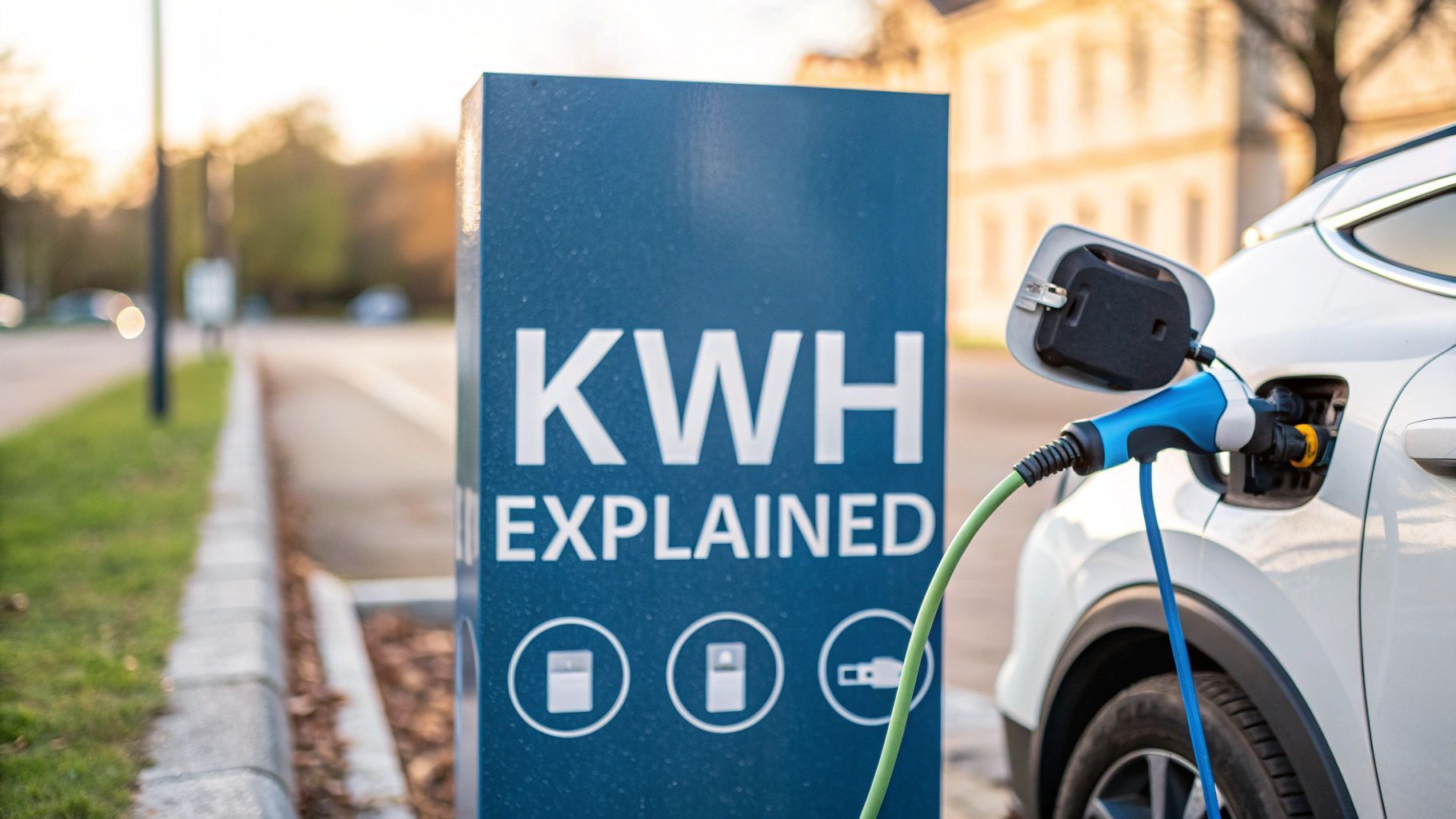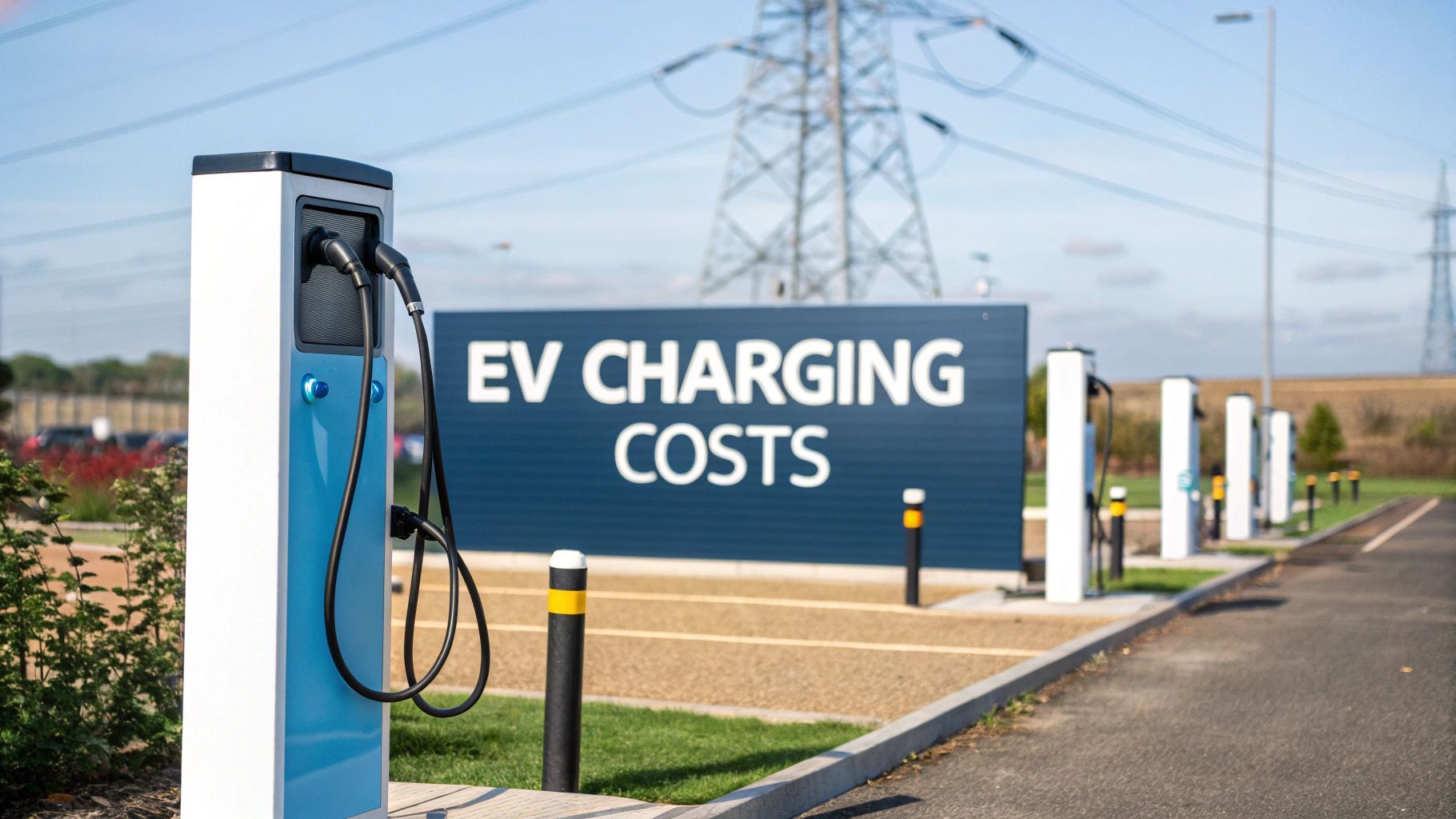Grid Scale Battery Storage Powering the UK
Ever thought about what happens to all that wind and solar power on a really gusty, sunny day? What if we could bottle it up for later? In essence, that's what grid-scale battery storage does. Think of it as a giant, rechargeable power bank for the entire country—a critical piece of the puzzle for ensuring the UK has a stable and reliable power supply for the future.
The Foundation of a Modern Energy Grid
Grid-scale battery storage facilities are fast becoming the backbone of Britain's modern energy system. They act like massive reservoirs for electricity. When our wind and solar farms are generating more power than we can use at that moment, instead of letting that clean energy go to waste, these huge batteries store it.
Then, when demand spikes in the evening as everyone gets home or on a calm, cloudy day when renewable generation drops off, that stored energy is released back into the grid. This simple act of balancing supply and demand is fundamental to preventing power outages and cutting our reliance on fossil fuel power stations. It’s the key to unlocking the full potential of renewables. You can learn more about how energy storage is the missing link in achieving 100% renewable energy in our detailed guide.
Powering the EV Revolution
The shift to electric vehicles (EVs) is brilliant but it is also putting a huge strain on the national grid. The sudden, high demand from rapid EV charging stations can easily destabilise local power networks, especially in areas where grid connections are constrained. Grid-scale batteries are the direct solution. By charging up during quiet, off-peak hours, they can then release that power to support charging hubs during the day, smoothing out those sharp peaks in demand.
This technology makes it possible to roll out the infrastructure we desperately need, from motorway service stations to mobile EV charging units, making sure drivers can power up without crashing the system. Implementing these systems is vital for improving overall grid stability and promoting better energy efficiency.
By acting as a buffer, grid scale batteries ensure that the grid can support the widespread adoption of EVs, effectively linking national energy strategy with the daily needs of drivers across Britain.
A Market Poised for Growth
The growing importance of this technology is clear from its rapid expansion. The UK’s utility-scale battery storage market is on a strong growth trajectory, with an expected compound annual growth rate (CAGR) of around 17.6% from 2025 to 2035 . This boom is being driven by the essential need for grid balancing and the rise of distributed energy systems. In 2025 alone, the market was valued at an estimated USD 48.1 billion, a figure projected to soar to USD 242.5 billion by 2035. You can discover more insights about this booming market on futuremarketinsights.com.
The Technology Driving the UK's Energy Transition
At the heart of every grid-scale battery storage facility, you'll find sophisticated technology designed to manage immense amounts of electrical energy safely and efficiently. To really get your head around how these systems work, we need to look at the components that make it all possible, starting with the batteries themselves.
This conceptual map gives a great overview of the fundamental role grid-scale battery storage plays in a modern energy system.
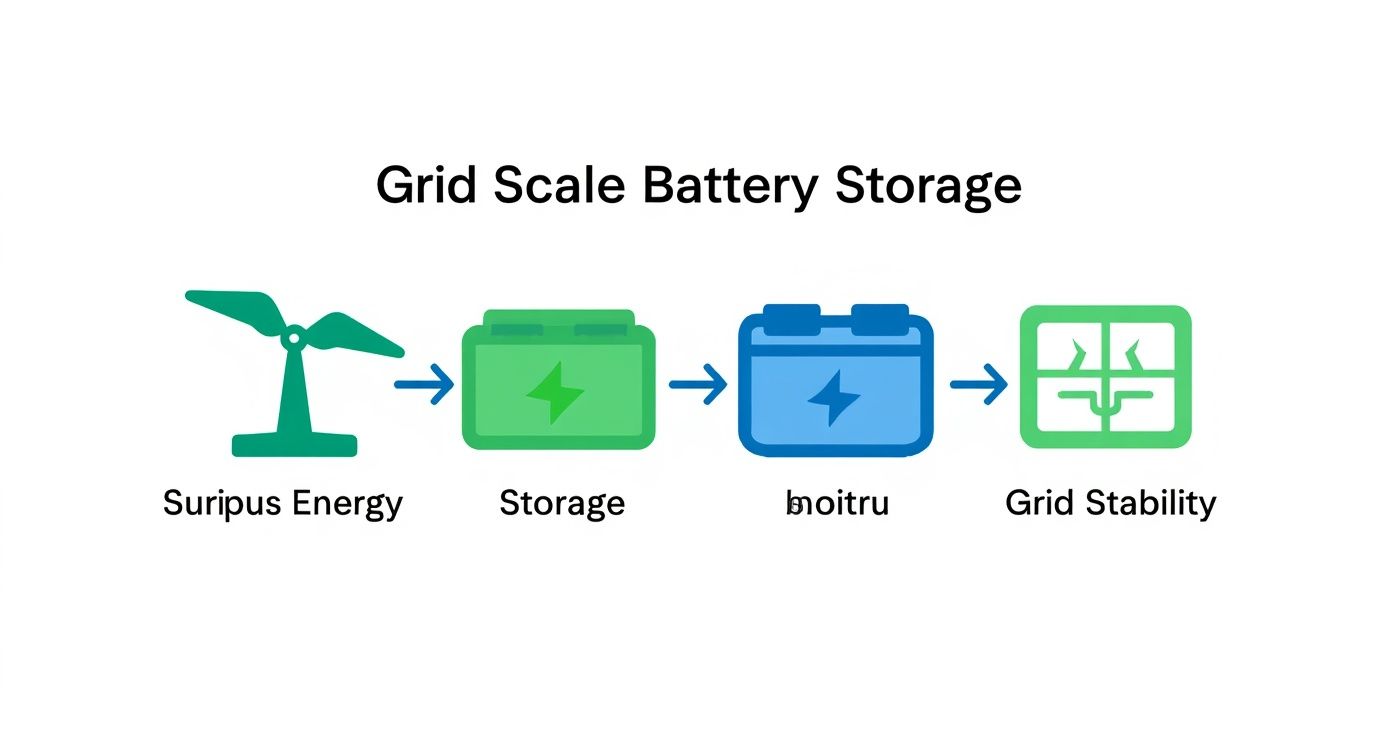
It shows how surplus renewable energy gets captured and stored, ready to be deployed to maintain grid stability and meet demand exactly when it's needed.
Comparing Grid Scale Battery Technologies
Not all batteries are created equal and the right choice of technology depends entirely on the job it needs to do. From providing split-second grid corrections to storing energy for days on end, different chemistries offer unique strengths and weaknesses.
The table below breaks down the primary battery technologies being used in grid-scale applications today, highlighting their key characteristics and where they fit best in the UK's energy puzzle.
| Technology Type | Key Advantages | Primary Limitations | Best Suited For |
|---|---|---|---|
| Lithium-Ion (Li-ion) | High energy density, rapid response time (milliseconds), mature technology with falling costs. | Best for short-duration storage ( 1-4 hours ), concerns around material sourcing and lifespan. | Frequency response, peak shaving, managing daily renewable fluctuations. |
| Flow Batteries | Highly scalable duration (just add more electrolyte), long lifespan with minimal degradation. | Lower energy density (larger footprint), less mature market, higher initial costs. | Long-duration storage ( 8+ hours ), providing grid resilience during extended lulls in renewables. |
As you can see, the industry is moving towards a 'horses for courses' approach, matching the right battery to the right grid challenge. While Li-ion remains dominant, the rise of flow batteries points to a more diverse and resilient storage landscape in the years ahead.
Lithium-Ion: The Current Market Leader
Right now, Lithium-ion (Li-ion) batteries are the undisputed champion in grid-scale applications. Popularised by everything from our mobile phones to electric vehicles, their mass production has caused manufacturing costs to plummet over the last decade.
Li-ion batteries offer fantastic energy density , which just means they can pack a lot of energy into a relatively small space. They also respond incredibly quickly, able to discharge power in milliseconds—a crucial feature for services like frequency response that keep the national grid stable.
However, Li-ion batteries are really built for short-duration storage, typically releasing their energy over a period of one to four hours . While that's perfect for smoothing out daily peaks in demand, they aren't the best solution for bridging longer gaps in renewable generation, like a few consecutive cloudy or windless days.
Emerging Alternatives for Long-Duration Storage
To solve the need for longer storage periods, other technologies are starting to gain serious traction. Flow batteries , for example, are a really promising alternative. Unlike a self-contained Li-ion battery, a flow battery stores its energy in external tanks of liquid electrolyte.
The key advantage here is scalability. To increase a flow battery’s storage duration, you simply make the tanks bigger. This makes them an excellent candidate for storing energy for eight hours or more, providing a robust buffer against prolonged lulls in wind or solar power.
While they're not as widespread as Li-ion just yet, flow batteries are poised to play a crucial role in securing the UK's energy supply as we lean more heavily on intermittent renewables. The ability to choose the right battery chemistry is central to building a flexible system; you can discover more by exploring what makes energy storage systems advanced and adaptable.
The Anatomy of a Battery Energy Storage System
A grid-scale storage facility is far more than just a big pile of batteries. It's a complex, integrated system known as a Battery Energy Storage System (BESS) , where several key components work together to manage the flow of energy seamlessly.
- Battery Modules: These are the fundamental building blocks. Individual battery cells are grouped into modules, which are then assembled into larger racks to build up the required capacity.
- Battery Management System (BMS): Think of this as the intelligent brain of the operation. The BMS constantly monitors the health of every single battery cell—tracking temperature, voltage and current to ensure safety and maximise its lifespan.
- Power Conversion System (PCS): This is the vital link between the batteries and the grid. The PCS converts the direct current (DC) from the batteries into the alternating current (AC) our homes and businesses use and it reverses the process when charging.
- Energy Management System (EMS): This is the high-level software orchestrating the whole show. The EMS decides when to charge or discharge based on grid demand, energy prices and forecasts for renewable generation.
Together, these components create a powerful and responsive tool for managing the national grid. They make everything possible, from enabling rapid EV charging from constrained grid connections to creating local, distributed energy networks when paired with combined on-site renewables. It’s this integrated approach that ensures a resilient power supply fit for the future.
Supercharging Britain's Electric Vehicle Ambitions
The UK’s shift to electric vehicles (EVs) is gaining real momentum but this huge change is putting our national power grid under immense pressure. As millions of cars go electric, they will start drawing massive amounts of power, often all at the same time. This is the point where grid-scale battery storage stops being a nice-to-have technology and becomes absolutely essential.
Think of a busy motorway service station during rush hour. Dozens of drivers plugging into rapid EV chargers all at once creates a colossal, sudden spike in power demand that can easily overwhelm the local grid connection, causing instability or even blackouts. A Battery Energy Storage System (BESS) acts as a powerful buffer against this exact problem.
The idea is simple but incredibly effective. The battery system charges itself overnight, pulling power from the grid when demand is low and electricity is cheapest, and there's often a surplus of renewable energy. During the day, it discharges this stored power to the charging hubs, shielding the main grid from those sharp, unpredictable demand peaks and making sure drivers can always get a fast, reliable charge.
Enabling Charging Infrastructure Everywhere
One of the biggest obstacles to building a truly national EV charging network is the grid itself. Many rural areas and even some older urban spots have constrained grid connections that just can't handle the power needed for a modern rapid charging hub. Without a fix, these communities risk being left behind.
Grid-scale batteries solve this problem beautifully. By placing a BESS right next to a charging station, developers can install vital infrastructure even where the grid connection is weak. The battery provides the high power needed for rapid EV charging, while only needing to sip a slow, steady trickle of electricity from the grid to top itself up over time.
This approach opens up a whole new world of possibilities for deploying charging infrastructure.
- Rapid Charging Hubs: It allows for multiple 150kW+ chargers to be installed in places that would otherwise be out of the question.
- Mobile EV Charging: It paves the way for fleets of vans fitted with large battery packs to offer temporary charging at events or for roadside assistance.
- Combined On-site Renewables: It makes it possible to create self-sufficient charging forecourts that pair on-site solar panels with grid scale batteries, generating and storing their own clean electricity.
The UK is already a leader in rolling out these systems, with a huge number of large-scale projects in the pipeline. This chart gives you a sense of some of the largest commercial BESS projects across the country.
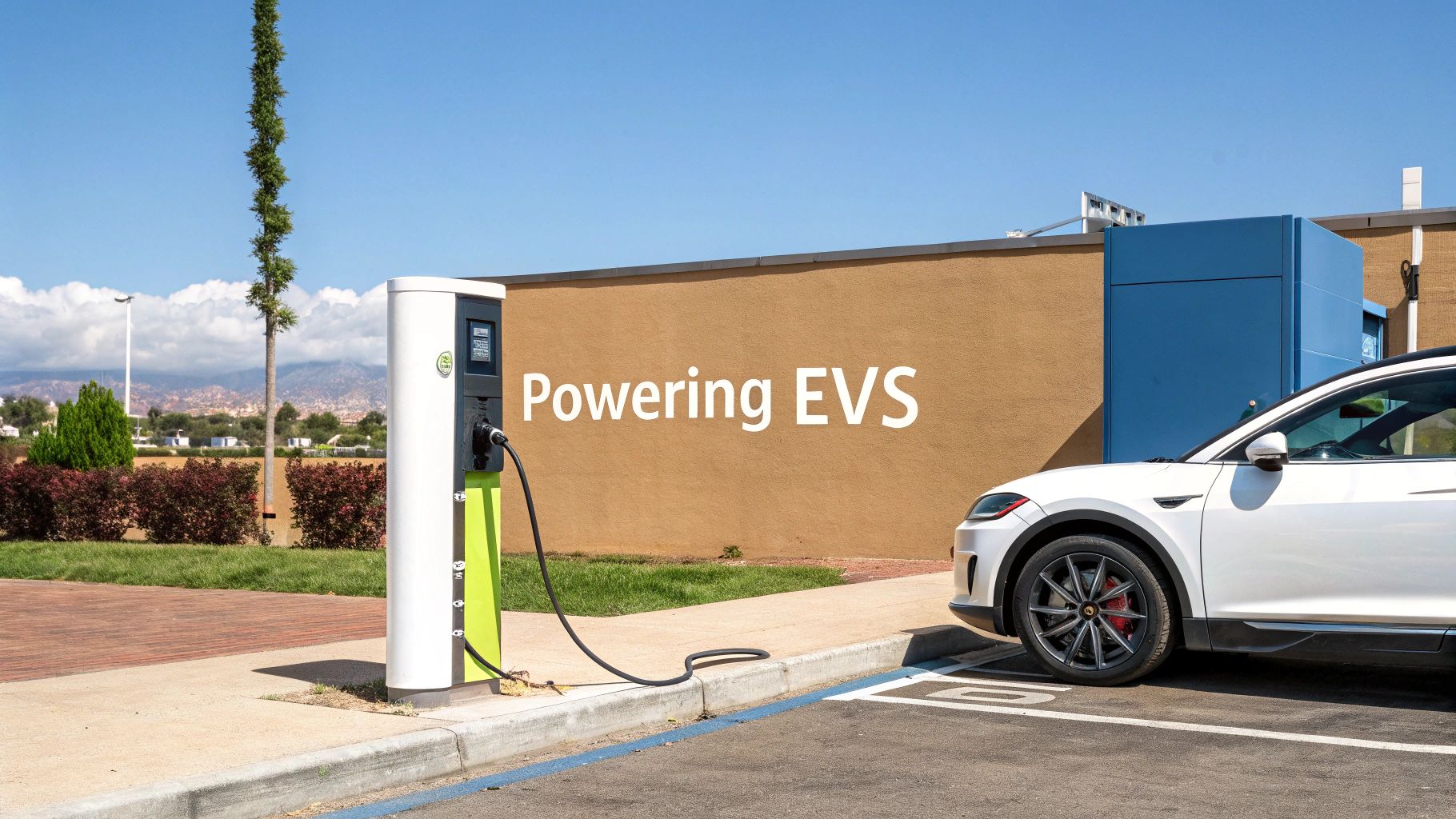
The data speaks for itself, showing the serious investment and scale of development underway. It cements the role of BESS in supporting both grid stability and the booming EV market.
Connecting National Strategy to Daily Driving
Weaving grid-scale battery storage into our EV infrastructure does more than just keep the lights on. It’s the missing link that connects high-level national energy strategy with the practical, day-to-day experience of an EV driver. It's the technology that ensures someone in a remote part of Scotland can get the same rapid charge as someone in central London.
By decoupling rapid EV charging speed from the strength of the local grid connection, battery storage ensures the EV rollout can be equitable, comprehensive and rapid. It is the critical enabler for a future where anyone, anywhere in the UK, can confidently switch to an electric vehicle.
Ultimately, this technology gives us the resilience and flexibility we need to support millions of new electric vehicles without having to pay for a prohibitively expensive and painfully slow overhaul of the entire national grid. It smooths demand, supports renewables and helps make the ambitious goal of ending petrol and diesel car sales by 2035 a tangible reality.
Pairing Renewables with Storage for a Resilient Grid
The biggest challenge for a power grid running on renewables is their intermittent nature. The sun doesn't always shine and the wind doesn't always blow. This simple fact is the main hurdle we need to clear on our journey towards a truly green and stable electricity supply.
This is where grid-scale battery storage steps in as the definitive solution. Think of a Battery Energy Storage System (BESS) as a huge energy reservoir. When solar panels and wind turbines are generating more electricity than we need, the BESS captures this abundant, low-cost power instead of letting it go to waste.
Then, when generation drops off or demand peaks in the evening, this stored energy is deployed to homes and businesses. This crucial partnership transforms intermittent renewables into a reliable, 24/7 power source, ensuring the lights stay on whatever the weather.
Maintaining Grid Stability in Real Time
Beyond simply storing energy for later use, grid-scale batteries provide vital services essential for the second-by-second stability of the national grid. One of the most critical is frequency response .
The grid must be kept at a stable frequency—around 50Hz in the UK. If too much power is generated, the frequency rises; if demand outstrips supply, it falls. Any significant deviation can damage equipment and lead to widespread blackouts.
In the past, this delicate balancing act was performed by fossil fuel power stations, which could ramp their output up or down. Today, a BESS can respond in milliseconds—far quicker than any traditional power plant—injecting or absorbing power to keep the grid perfectly balanced.
This near-instant response capability makes battery storage an indispensable tool for grid operators. It provides a level of control and resilience essential for a modern, renewables-led system. As more communities focus on transitioning from traditional energy to solar , this stabilising function becomes even more important.
The Rise of Distributed Energy
The combination of combined on-site renewables and grid scale batteries is also powering a shift towards a more decentralised energy model. This is the concept of distributed energy , where power is generated and stored closer to where it's used, rather than relying solely on large, centralised power stations.
Imagine a business park with solar panels on every roof and a shared battery system on-site. This setup can create a resilient, localised power network, often called a microgrid.
- Increased Resilience: During a national grid outage, the local network can continue to operate independently, keeping critical services running.
- Reduced Grid Strain: By generating and consuming their own power, these sites reduce the overall load on the national transmission network.
- Cost Savings: Businesses can store cheap solar energy during the day and use it during peak hours, significantly lowering their electricity bills.
- EV Charging Support: On-site batteries make it feasible to install rapid EV charging points without needing expensive grid upgrades, solving a major infrastructure challenge for fleets and commercial properties.
This model isn't just a future concept; it's being deployed across the UK today. Companies are actively integrating renewable energy with advanced storage solutions to create self-sufficient and cost-effective energy ecosystems. This approach builds a more robust and flexible grid, one that can support everything from rapid EV charging to mobile power for remote sites.
Ultimately, the synergy between renewables and storage is the true foundation of a resilient, low-carbon energy future for Britain.
Spotlighting the UK's Battery Storage Boom
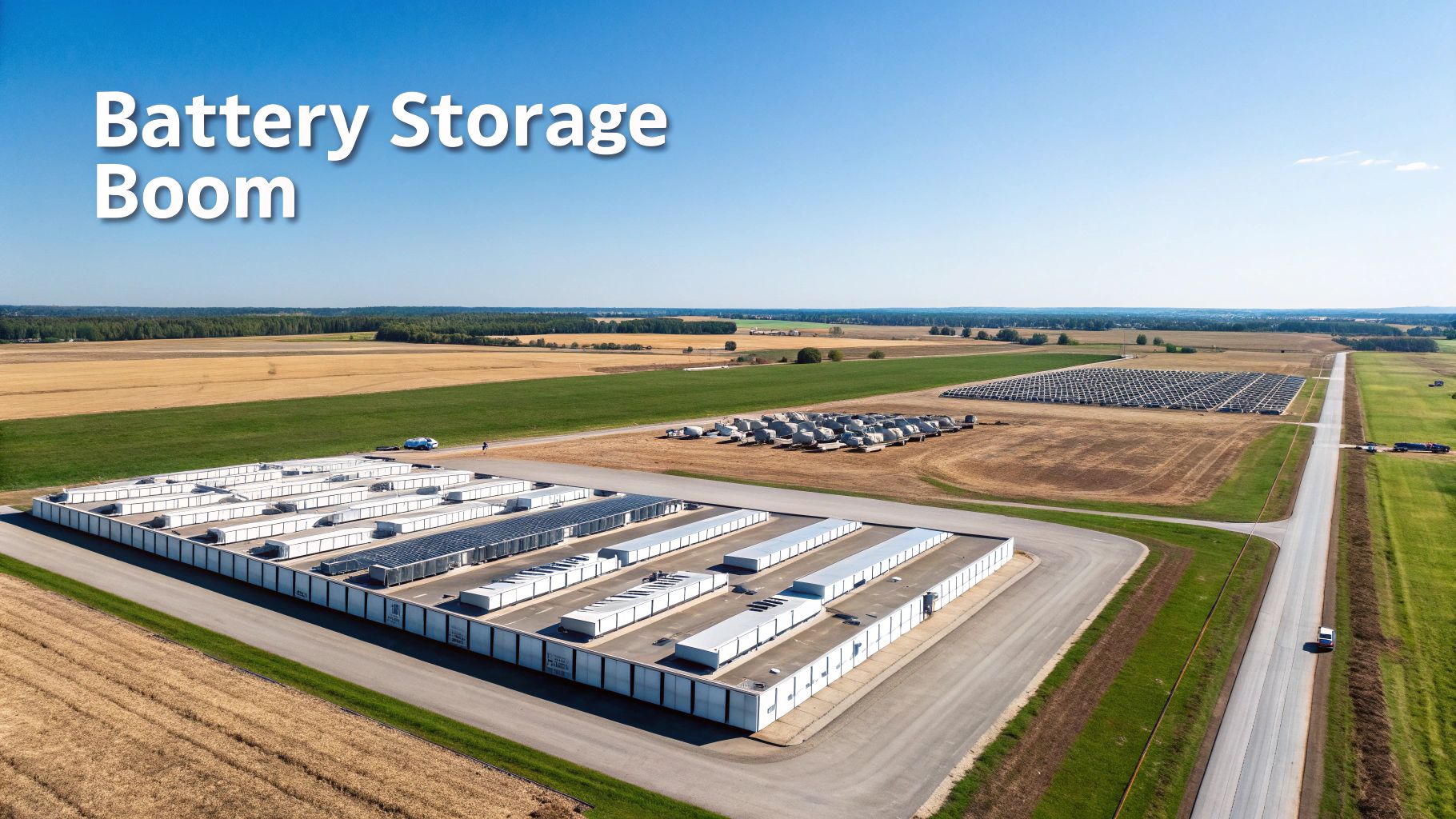
It’s no secret that Britain’s grid-scale battery storage capacity has exploded in recent years. What was once a niche technology is now a cornerstone of our energy strategy.
This incredible growth hasn't happened by accident. It's been driven by a combination of smart government policies and plummeting costs, creating the perfect conditions for investment and innovation.
Let's dig into the key drivers, look at some of the flagship projects making a difference and see what this all means for the UK's bigger energy goals.
The Key Drivers Behind This Rapid Growth
So, what's pouring fuel on the fire? A few key factors are at play. Government auctions for new battery projects have been crucial, as they essentially de-risk the investment and provide guaranteed returns for developers.
This stability has caught the eye of private funds, who now see these Battery Energy Storage Systems (BESS) as a reliable way to generate income, especially when energy prices are all over the place. On top of that, the network operators themselves are using storage to better manage daily peak demand and keep the grid's frequency stable.
It boils down to a few core elements:
- Contracts for Difference schemes are anchoring long-term revenue streams for projects.
- The cost of battery cells has fallen dramatically, leading to 30% overall cost declines since just 2020.
- Strong investor appetite is pushing the pipeline of planned projects past an incredible 15 GW .
Major BESS Projects Across Britain
Several massive installations are already shaping the UK's energy landscape. These aren't just theoretical concepts; they are real, working powerhouses.
- Clay Tye, Essex: A huge 100 MW / 200 MWh facility designed to shave the peaks off daily demand and give the grid much-needed flexibility.
- Statera, Cornwall: Here, 90 MW / 180 MWh of storage is paired directly with a solar farm to bank sunshine during the day and release it to power homes in the evening.
- Uskmouth, Wales: This 50 MW / 100 MWh site acts as a crucial backup, providing capacity to maintain local frequency stability when it's needed most.
It’s happening all over the country. A scheme in East Anglia is being used to smooth out the fluctuating output from the region’s vast wind farms, while another site in Glasgow delivers lightning-fast response services to keep the grid perfectly balanced at its target of 50 Hz .
“These projects are reshaping how we manage intermittent renewables” – EnergyPulse analyst
Record-Breaking Capacity Expansion
The numbers behind this expansion are staggering. Between 2020 and 2025, the UK’s operational BESS fleet jumped from 1,128 MW to 6,872 MW.
That's a 509% increase in just five years.
To put that into perspective, in 2025 alone, developers brought 1,405 MW of new capacity online, highlighting just how fast these projects are being built. If you want to dive deeper into the data, Blackridge Research offers some great insights into the UK's growth.
Impact On Energy Security And Climate Goals
These battery installations are fundamental to our national resilience. By absorbing excess power and injecting it back in milliseconds, they act as a shock absorber for the grid, dampening supply swings and preventing blackouts.
Crucially, they are also helping us clean up our act. By replacing old, dirty diesel "peaker" plants that used to fire up during high demand, BESS projects are cutting carbon emissions by up to 60% .
Their impact is threefold:
- Strengthening grid stability during peak demand.
- Accelerating the integration of renewables, even when it isn't windy or sunny.
- Supporting the UK’s wider Clean Power 2030 objectives.
Connecting Investment To Everyday Use
This boom isn't just about massive, grid-scale projects. It's creating tangible opportunities for businesses and local communities, too.
Local authorities can now partner on microgrids that combine shared battery storage with rooftop solar panels, creating more self-sufficient communities. Commercial fleets are also benefiting, installing rapid EV chargers without needing expensive and time-consuming grid upgrades, thanks to onsite batteries. We're even seeing mobile EV charging vans, powered by battery packs, supporting everything from festivals to remote construction sites.
Looking Ahead To Continued Expansion
The momentum shows no signs of slowing down. As battery cell prices continue to fall and new financing models emerge, we can expect the scale-up to continue.
The pipeline data is mind-boggling, with over 127 GW of storage projects currently at various stages of planning across the country.
What's more, we're seeing better regional equity in where these projects are built. Scotland, Wales and Northern Ireland are now hosting a growing number of schemes, spreading the benefits more evenly. This blistering pace of development is cementing the UK’s position as a genuine world leader in grid-scale battery storage.
Future Innovations and Upcoming Challenges
The world of grid-scale battery storage never stands still. The drive for greater efficiency, lower costs and longer operational lifecycles means researchers and engineers are constantly pushing the boundaries of what these systems can do. The goal? A power grid that's not just more sustainable but far more resilient.
Leading the charge is the hunt for the next generation of battery chemistries. While lithium-ion is today’s workhorse, promising new technologies like solid-state and sodium-ion batteries are gathering momentum. These alternatives are designed to pack in more energy and last longer, all while using materials that are more abundant and ethically sourced—a vital factor for scaling up storage capacity across the globe.
The Role of Artificial Intelligence
It’s not just about the hardware, though. The intelligence managing these systems is becoming just as crucial. Artificial intelligence (AI) and machine learning algorithms are now being used to fine-tune exactly how and when a grid-scale battery storage system charges and discharges.
By crunching huge amounts of data—everything from weather forecasts and historical energy demand to real-time market prices—AI can make split-second decisions to get the most out of a battery, both in terms of efficiency and profitability. Imagine it predicting a surge in solar power, charging the battery when electricity is cheapest and then selling that power back to the grid when prices peak. This kind of intelligent management makes sure not a single kilowatt-hour goes to waste.
This data-driven approach is essential for maximising the value of distributed energy assets, ensuring that everything from a rapid EV charging hub to a large utility-scale BESS operates at peak performance and provides the best possible return on investment.
Navigating the Road Ahead
Despite the bright future, the path forward has its share of bumps. For starters, securing a stable supply of critical minerals like lithium and cobalt is a major challenge. The industry has to navigate complex geopolitics and invest heavily in recycling to create a more sustainable, circular economy for these materials.
On top of that, developers face very real hurdles on the ground. Getting through complex planning permissions and securing a grid connection can be a painfully slow process. These queues and regulatory hoops can sometimes stall projects that are otherwise viable and desperately needed.
The market itself is also a whirlwind of activity, which brings both opportunity and fierce competition. In the UK, the first half of 2025 saw an incredible surge, with project completions jumping 78% year-on-year. During the same period, planning applications rose by 25% and approvals shot up by 49% —a clear sign of massive investor confidence. You can dig into more of this data on the UK’s soaring battery storage activity on energy-storage.news. Of course, this rapid expansion also underlines the urgent need for continued investment in our grid infrastructure just to keep up.
Frequently Asked Questions
It’s one thing to talk about grid-scale technology but it’s another to understand what it means for you, your community and your energy bills. Here are some straightforward answers to the questions we hear most often.
How Does Grid Scale Battery Storage Help My Electricity Bill?
While you won’t see a line item for 'battery storage' on your bill, the effect is real, just indirect. Think of it this way: these large batteries store huge amounts of cheap renewable energy when it’s sunny or windy.
They then release that stored power back onto the grid during peak times when electricity would normally be most expensive. This reduces the need to fire up costly gas power plants to meet demand, which helps keep the wholesale price of energy more stable and ultimately lower for everyone.
Are These Battery Facilities Safe?
Absolutely. Safety isn't just a consideration; it's the foundation these facilities are built on. Every installation must meet strict UK and international standards and they include multiple layers of advanced safety systems.
- Battery Management Systems (BMS): These act as the brain of the operation, constantly monitoring the temperature, voltage and current of every single cell to catch potential issues long before they become problems.
- Advanced Fire Safety: Sophisticated fire detection and suppression systems are designed into the facility from day one, not added as an afterthought.
- Layered Protection: Multiple physical and software safeguards work together to ensure the system always operates safely within its limits.
What Is the Lifespan of a Grid Scale Battery?
A typical grid-scale lithium-ion battery system is built to perform for 10 to 20 years . The exact lifespan depends on its specific chemistry and how hard it’s worked over its lifetime. Like any battery, its ability to hold a full charge will gradually decrease after thousands of charging and discharging cycles.
But "end-of-life" for grid services doesn't mean it's destined for the scrap heap. A growing circular economy is emerging to give these batteries a second life in less demanding roles or to recycle them, recovering valuable materials like lithium, cobalt and nickel.
By repurposing and recycling, the industry maximises the value of these assets, ensuring that the critical minerals within them are recovered and reused to build the next generation of clean energy technology.
Can These Batteries Power My Home During a Blackout?
Not directly. Grid-scale batteries operate at a macro level, working to prevent blackouts from happening in the first place across entire regions. Their main job is to keep the grid's frequency and voltage stable, making widespread power cuts much less likely.
They are the silent guardians of the grid, not a backup generator for individual houses. If you're looking for backup power for your own home, you would need a much smaller, domestic battery storage system.
At ZPN Energy , we are at the forefront of deploying the energy infrastructure of tomorrow. From rapid EV charging solutions supported by on-site battery storage to large-scale grid services, we provide the integrated systems needed to build a resilient, low-carbon future. Discover our advanced energy solutions at https://www.zpnenergy.com.


